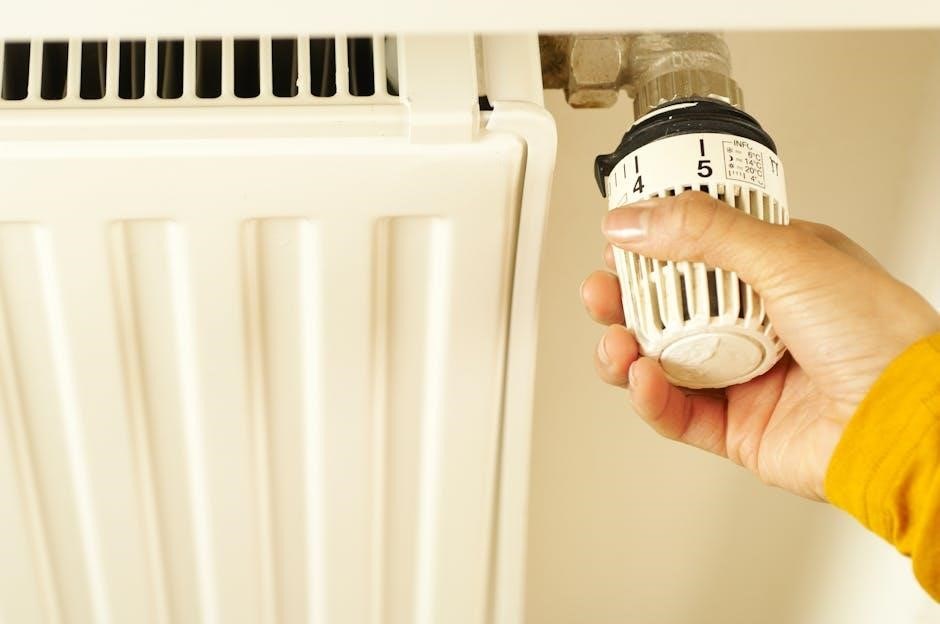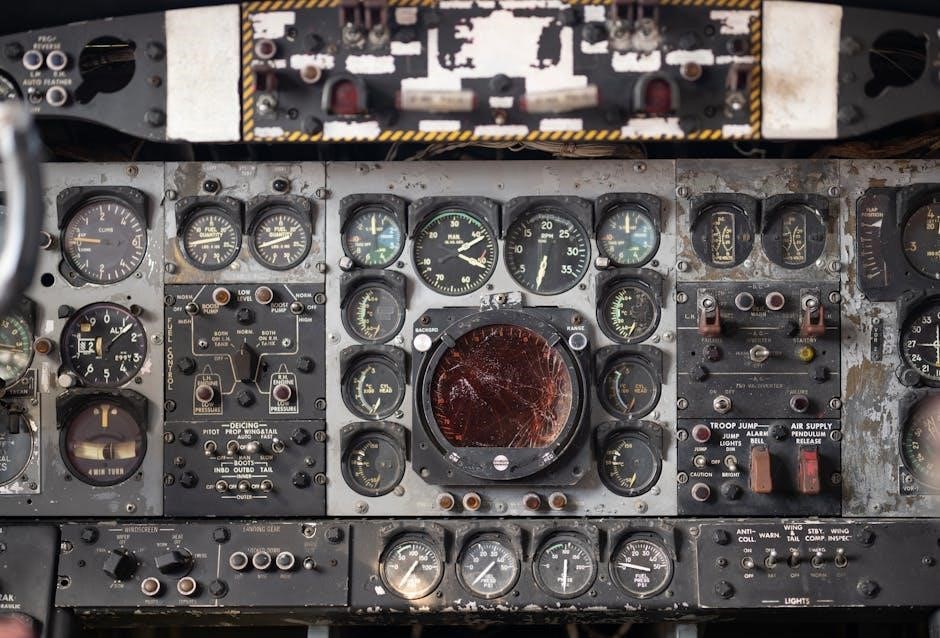Manual air valves are essential components in pneumatic systems, enabling precise control over airflow, pressure, and direction. They are fundamental for regulating air supply in various applications.
1.1 Definition and Purpose
Manual air valves are mechanical devices designed to control the flow of compressed air in pneumatic systems. Their primary purpose is to regulate the direction, pressure, and flow rate of air, ensuring efficient operation in various applications. These valves are essential for managing air supply, enabling precise control over system performance and functionality.
1.2 Importance in Pneumatic Systems
Manual air valves are crucial for controlling airflow, ensuring efficient operation in pneumatic systems. They regulate pressure, direction, and flow rate, preventing system damage and optimizing performance. Their reliability in managing compressed air makes them indispensable in industrial automation, enabling precise control and maintaining safety standards across various applications.

Working Principle of Manual Air Valves
Manual air valves operate by using a mechanical actuator to open or close the valve, controlling airflow through a stem-connected valve opening or port.

2.1 Mechanical Operation
The mechanical operation of manual air valves involves a physical mechanism, such as a handle or lever, linked to a stem that moves a valve plug or disc. Turning the handle rotates the stem, opening or closing the valve orifice to regulate airflow. This simple, reliable mechanism ensures precise control over pneumatic systems without requiring external power sources, making them durable and low-maintenance solutions for various applications.
2.2 Air Flow Control Mechanisms
Manual air valves regulate airflow through mechanisms like valve plugs, discs, or balls, which are actuated by handles or levers. These components control the flow by opening, closing, or partially obstructing the valve orifice. The design ensures precise modulation of air pressure and flow rate, enabling reliable operation in diverse applications while maintaining simplicity and efficiency in pneumatic system management.

Types of Manual Air Valves
Manual air valves are categorized into ball, butterfly, and needle valves, each designed for specific applications, offering unique flow control, durability, and operational efficiency.
3.1 Ball Valves
Ball valves are widely used manual air valves featuring a rotating ball with a central bore. They offer excellent sealing, durability, and ease of operation, making them ideal for applications requiring precise airflow control. Their compact design and quick ON/OFF operation suit various industrial and pneumatic systems, ensuring efficient performance and minimal maintenance needs.
3.2 Butterfly Valves
Butterfly valves are manual air valves with a rotating disc that controls airflow. Their lightweight, compact design makes them ideal for large pipe systems. They offer quick operation, low maintenance, and cost-effectiveness. Commonly used in industrial and HVAC systems, butterfly valves provide precise control over air flow, making them a versatile choice for various pneumatic applications.

3.3 Needle Valves
Needle valves are manual air valves with a needle-like stem for precise airflow control. They are ideal for applications requiring fine-tuning, such as in pneumatic systems, medical devices, and aerospace. Their design allows for gradual opening and closing, ensuring minimal air leakage and accurate pressure regulation. Durability and ease of maintenance make them a preferred choice in various industries.

Applications of Manual Air Valves
Manual air valves are crucial in manufacturing, laboratories, medical devices, and power generation, ensuring precise airflow control in pneumatic systems and specialized equipment.
4.1 Industrial Automation
In industrial automation, manual air valves play a pivotal role in controlling airflow to actuators, cylinders, and machinery. They enable precise regulation of pneumatic operations, ensuring efficient production processes. These valves are integral in manufacturing setups, allowing operators to manage air supply seamlessly, which is critical for maintaining system performance and productivity levels consistently.
4.2 HVAC Systems
Manual air valves are crucial in HVAC systems for controlling airflow, ensuring efficient heating, ventilation, and cooling. They regulate air distribution across zones, allowing precise temperature management. These valves are essential for system setup, maintenance, and balancing, ensuring optimal energy use and consistent indoor air quality, making them indispensable in modern climate control applications.
4.3 Automotive Systems
Manual air valves are integral in automotive systems, controlling airflow for engine performance, emissions regulation, and braking systems. They ensure precise air-fuel mixture, optimize fuel efficiency, and maintain proper vacuum levels. In braking systems, they regulate air pressure, ensuring reliable operation. Their role is vital for maintaining vehicle efficiency, safety, and compliance with emissions standards, making them essential components in modern vehicles.
Safety Considerations
Manual air valves require adherence to safety guidelines to prevent accidents. Proper installation, regular inspection, and understanding maximum pressure limits are crucial. Following manufacturer recommendations ensures safe operation and system integrity.
5.1 Proper Installation
Proper installation of manual air valves is critical for system efficiency and safety. Ensure tight connections to prevent air leaks, use compatible materials, and follow manufacturer guidelines. Mount valves correctly, considering flow direction and accessibility; Pressure-test the system post-installation to verify integrity. Adhering to these steps minimizes risks and ensures optimal performance.
5.2 Maintenance Best Practices
Regular maintenance ensures manual air valves function optimally. Inspect for wear, clean or replace seals, and lubricate moving parts. Check for air leaks and tighten connections as needed. Schedule periodic servicing to prevent corrosion and ensure smooth operation. Proper maintenance extends valve lifespan and maintains system performance. Always refer to the manufacturer’s guidelines for specific recommendations.

Troubleshooting Common Issues

Identify air leaks by inspecting connections and seals. Address valve sticking by cleaning or replacing worn parts. Use appropriate tools for repair to ensure proper functionality.
6.1 Air Leaks
Air leaks are a common issue in manual air valves, often caused by worn seals, loose connections, or damaged gaskets. To detect leaks, apply a soap solution or listen for hissing sounds near valve connections. Repair involves replacing seals, tightening fittings, or rethreading connections. Regular inspection and maintenance are crucial to prevent air leaks and ensure optimal system performance and efficiency.

6.2 Valve Sticking
Valve sticking occurs when the valve’s moving parts fail to operate smoothly, often due to dirt, corrosion, or old grease. This issue can disrupt airflow control and system performance. To resolve it, clean the valve thoroughly, apply appropriate lubricants, and replace worn or damaged components. Regular maintenance and inspections help prevent sticking, ensuring reliable operation and longevity of the manual air valve.
Advantages and Limitations
Manual air valves offer reliability, simplicity, and cost-effectiveness but lack automation capability, requiring manual intervention for operation, which can limit their use in advanced systems.
7.1 Reliability and Simplicity
Manual air valves are renowned for their reliability due to their straightforward design and minimal moving parts, reducing the risk of mechanical failure. Their simplicity ensures easy operation and maintenance, making them a preferred choice in systems where consistent airflow control is essential. This durability and ease of use contribute to their widespread adoption in various industrial applications.
7.2 Limited Automation Capability
Manual air valves lack automation features, requiring physical operation, which limits their integration with modern automated systems. This dependency on manual intervention can hinder efficiency in applications requiring precise, real-time control. While reliable in simple setups, they are less suitable for industries demanding advanced automation, making them a less favorable choice for systems needing rapid, programmable airflow adjustments and remote monitoring capabilities.
Installation and Maintenance Tips
Ensure proper installation by following manufacturer guidelines, using correct tools, and maintaining a clean environment. Regularly inspect and clean valves to prevent dust and debris buildup.
8.1 Step-by-Step Installation Guide
Begin by preparing the valve and ensuring all components are included. Mount the valve in the correct position, ensuring proper alignment. Connect the air supply line securely, using appropriate fittings and seals. Tighten all connections firmly but avoid over-tightening. Test the valve by operating it several times to ensure smooth function. Finally, inspect for leaks and ensure compliance with safety standards.
8.2 Regular Maintenance Schedule
Regular maintenance ensures optimal performance and longevity of manual air valves. Clean the valve regularly to remove dirt and debris. Inspect seals and O-rings for wear and replace them as needed. Lubricate moving parts periodically to maintain smooth operation. Check for air leaks around connections and tighten if necessary. Schedule maintenance every three to six months to prevent malfunctions and ensure system efficiency. Replace worn components promptly to avoid downtime.
Manual air valves are crucial for controlling airflow in pneumatic systems, offering reliability and simplicity. Proper maintenance enhances durability, ensuring efficient operation across various applications, and future innovations may further optimize their performance.
9.1 Summary of Key Points
Manual air valves are pivotal in pneumatic systems, providing precise airflow control. Their simplicity and reliability make them indispensable in various applications. Proper installation and maintenance are crucial for optimal performance, while future trends may integrate advanced technologies to enhance functionality and efficiency.
9.2 Future Trends in Manual Air Valves
Future trends in manual air valves include advancements in materials science for enhanced durability and corrosion resistance. Integration with smart technologies, such as IoT-enabled sensors, may offer real-time monitoring and improved control. Additionally, there is a growing focus on energy-efficient designs to reduce air leakage and optimize performance in industrial and automation systems.
